Changes in Fish Assemblage Structure after Pen Culture Removal in Gehu Lake, China
Abstract
1. Introduction
2. Materials and Methods
2.1. Study Area
2.2. Method
2.3. Data Analysis
2.3.1. Ecological Types
2.3.2. Community Diversity
2.3.3. Relative Importance Index
2.3.4. Community Stability
2.3.5. Community Clustering Characteristics
3. Results
3.1. Fish Species Composition and Ecological Types
3.2. Dominant Species
3.3. Community Structure and Stability
3.4. Fish Composition in the Northern Conservation Area
3.5. Fish Composition in the Southern Seine Area
3.6. Fish Composition in the Ecological Restoration Area
3.7. Community Stability
3.8. Community Diversity
4. Discussion
4.1. Species Composition
4.2. Dominant Species
4.3. Community Structure and Stability
5. Conclusions
Author Contributions
Funding
Institutional Review Board Statement
Data Availability Statement
Conflicts of Interest
References
- Nunoo, F.K.E.; Asamoah, E.K.; Osei-Asare, Y.B. Economics of Aquaculture Production: A Case Study of Pond and Pen Culture in Southern Ghana. Aquac. Res. 2014, 45, 675–688. [Google Scholar] [CrossRef]
- Gu, X.; Mao, Z.; Ding, H.; Wang, Y.; Zeng, Q.; Wang, L. Progress and Prospect of Lake Fishery. J. Lake Sci. 2018, 30, 1–14. [Google Scholar]
- Liu, J.; Wang, Q.; Zhang, T.; Ye, S.; Li, W.; Yuan, J.; Li, Z. Development of lake and reservoir aquaculture related practices in China. Aquac. China: Success Stories Mod. Trends. 2018, 599–610. [Google Scholar]
- Alam, A.; Joshi, K.D.; Das, S.C.; Jha, D.N.; Srivastava, K.; Kumar, V.; Bhattacharjya, B.K. Enhancing Fish Productivity through Pen Culture: A Case Study in Sareni Wetland of Uttar Pradesh. Indian J Fish. 2017, 64, 8–13. [Google Scholar] [CrossRef][Green Version]
- Jia, P.; Zhang, W.; Liu, Q. Lake Fisheries in China: Challenges and Opportunities. Fish. Res. 2013, 140, 66–72. [Google Scholar] [CrossRef]
- Musinguzi, L.; Lugya, J.; Rwezawula, P.; Kamya, A.; Nuwahereza, C.; Halafo, J.; Kamondo, S.; Njaya, F.; Aura, C.; Shoko, A.P.; et al. The Extent of Cage Aquaculture, Adherence to Best Practices and Reflections for Sustainable Aquaculture on African Inland Waters. J. Gt. Lakes Res. 2019, 45, 1340–1347. [Google Scholar] [CrossRef]
- Tang, S.K.; Zhang, T.Q.; Kong, Y.J.; Hua, S.P.; Wang, X.F. Ichthyological Survey and Fish Yield Analysis of Lake Gehu. J. Hydroecology 2009, 30, 20–24. [Google Scholar]
- Xiong, C.H.; Zhang, R.L.; Wu, X.D.; Feng, L.H.; Wang, L.Q. Distribution and Pollution Assessment of Nutrient and Heavy Metals in Surface Sediments from Lake Gehu in Southern Jiangsu Province, China. Environ. Sci. 2016, 37, 925–934. [Google Scholar] [CrossRef]
- Gao, Y.Y.; Zhou, J.; Chen, Z.N.; Shen, L.J.; Xu, D.J. Research on Succession and Rehabilitation of Submerged Macrophytes in the Process of Eutrophication of Gehu Lake. Environ. Sci. Technol. 2008, 4, 21–24. [Google Scholar]
- Tao, H.; Pan, J.Z.; Shen, Y.L.; Li, W.C.; Huang, F. Overview and Degradation Reasons of Submerged Macrophytes of Gehu Lake. Environ. Sci. Technol. 2010, 23, 64–68. [Google Scholar]
- Xu, X.; Zhang, L.; Xue, Y.; Gao, Y.; Wang, L.; Peng, M.; Jiang, S.; Zhang, Q. Microplastic Pollution Characteristic in Surface Water and Freshwater Fish of Gehu Lake, China. Environ. Sci. Pollut. Res. 2021, 28, 67203–67213. [Google Scholar] [CrossRef]
- Xie, H.; Jiang, Z.G.; Xia, Z.J.; Guo, W. The Impacts of Enclosure Aquaculture on Fish Community in the Huayanghe Lake. J. Fish. China 2018, 42, 1399–1407. [Google Scholar]
- Gu, X.K.; Shen, D.D.; Gui, Z.Y.; Liu, Y.S.; Tang, S.K.; Li, D.M.; Zhang, T.Q.; Zhang, Z.; He, H.R. Study on Community Structure and Biodiversity of Fish in East Taihu Lake after Removal of Net Enclosure. J. Aquac. 2022, 43, 1–9. [Google Scholar]
- Karr, J.R. Assessment of Biotic Integrity Using Fish Communities. Fisheries 1981, 6, 21–27. [Google Scholar] [CrossRef]
- McCormick, F.H.; Peck, D.V.; Larsen, D.P. Comparison of Geographic Classification Schemes for Mid-Atlantic Stream Fish Assemblages. J. North Am. Benthol. Soc. 2000, 19, 385–404. [Google Scholar] [CrossRef]
- Villéger, S.; Brosse, S.; Mouchet, M.; Mouillot, D.; Vanni, M.J. Functional Ecology of Fish: Current Approaches and Future Challenges. Aquat. Sci. 2017, 79, 783–801. [Google Scholar] [CrossRef]
- Karjalainen, J.; Leppä, M.; Rahkola, M.; Tolonen, K. The Role of Benthivorous and Planktivorous Fish in a Mesotrophic Lake Ecosystem. In Shallow Lakes’ 98; Springer: Dordrecht, The Netherlands, 1999; pp. 73–84. [Google Scholar]
- Makler-Pick, V.; Gal, G.; Shapiro, J.; Hipsey, M.R. Exploring the Role of Fish in a Lake Ecosystem (Lake Kinneret, Israel) by Coupling an Individual-Based Fish Population Model to a Dynamic Ecosystem Model. Can. J. Fish. Aquat. Sci. 2011, 68, 1265–1284. [Google Scholar] [CrossRef]
- Zhu, S.Q. Synopsis of Freshwater Fishes of China; Jiangsu Publishing House of Science and Technology: Nanjing, China, 1995. [Google Scholar]
- Ni, Y.; Wu, H.L. Fishes of Jiangsu Province; China Agriculture Press: Beijing, China, 2006. [Google Scholar]
- Margalef, D.R. Information theory in ecology. Int. J. Gen. Syst. 1958, 3, 36–71. [Google Scholar]
- Pielou, E.C. Ecological Diversity; John Wiley and Sons: New York, NY, USA, 1975; Volume 165. [Google Scholar]
- Clarke, K.; Ainsworth, M. A Method of Linking Multivariate Community Structure to Environmental Variables. Mar. Ecol. Prog. Ser. 1993, 92, 205–219. [Google Scholar] [CrossRef]
- Pinkas, L. Food Habits of Albacore, Bluefin Tuna, and Bonito in California Waters. Fish Bull. 1971, 152, 1–105. [Google Scholar]
- Warwick, R.M. A New Method for Detecting Pollution Effects on Marine Macrobenthic Communities. Mar. Biol. 1986, 92, 557–562. [Google Scholar] [CrossRef]
- Yemane, D.; Field, J.G.; Leslie, R.W. Exploring the Effects of Fishing on Fish Assemblages Using Abundance Biomass Comparison (ABC) Curves. ICES J. Mar. Sci. 2005, 62, 374–379. [Google Scholar] [CrossRef]
- Clarke, K.R.; Warwick, R.M. Changes in Marine Communities: An Approach to Statistical Analysis and Interpretation. Mt. Sinai J. Med. N. Y. 2001, 40, 689–692. [Google Scholar]
- Liu, Z.D.; Hong, C.S. The development and utilization of the aquatic resources of Gehu Lake. Nat. Resour. 1993, 15, 52–56. [Google Scholar]
- Li, J.W.; Xu, D.P.; Li, W.; Kong, Y.; Hua, S.; Liu, Q.; Zhang, S.; Hu, Z. Spatial and Temporal Distribution of Fish Assemblages and its Relationship with Environmental Factors in Lake Gehu. J. Fish. China 2022, 46, 546–556. [Google Scholar]
- De Silva, S.S.; Nguyen, T.T.T.; Turchini, G.M.; Amarasinghe, U.S.; Abery, N.W. Alien Species in Aquaculture and Biodiversity: A Paradox in Food Production. Ambio 2009, 38, 24–28. [Google Scholar] [CrossRef]
- Gozlan, R.E. Introduction of Non-Native Freshwater Fish: Is It All Bad. Fish Fish. 2008, 9, 106–115. [Google Scholar] [CrossRef]
- Yu, F.D.; Gu, D.E.; Tong, Y.N.; Li, G.J.; Wei, H.; Mu, X.D.; Xu, M.; Yang, Y.X.; Luo, D.; Li, F.Y.; et al. The Current Distribution of Invasive Mrigal Carp (Cirrhinus mrigala) in Southern China, and Its Potential Impacts on Native Mud Carp (Cirrhinus molitorella) Populations. J. Freshw. Ecol. 2019, 34, 603–616. [Google Scholar] [CrossRef]
- Green, D.M.; Penman, D.J.; Migaud, H.; Bron, J.E.; Taggart, J.B.; McAndrew, B.J. The Impact of Escaped Farmed Atlantic Salmon (Salmo salar L.) on Catch Statistics in Scotland. PLoS ONE. 2012, 7, e43560. [Google Scholar] [CrossRef]
- Yang, Z.P.; Lu, Q.Q. Exotic Fish Potential Hazards in Dongguan Reaches of Dongjiang River and its Coping Strategies. J. Green Sci. Technol. 2016, 10, 149–151. [Google Scholar] [CrossRef]
- Rahel, F.J. Intentional Fragmentation as a Management Strategy in Aquatic Systems. BioScience 2013, 63, 362–372. [Google Scholar] [CrossRef]
- Gu, D.E.; Wang, J.W.; Xu, M.; Mu, X.D.; Wei, H.; Yu, F.D.; Fang, M.; Wang, X.J.; Song, H.M.; Yang, Y.X.; et al. Does aquaculture aggravate exotic fish invasions in the rivers of southern China? Aquaculture 2022, 547, 737492. [Google Scholar] [CrossRef]
- Huang, G.; Wang, Q.; Yuan, T.; Mu, X.D.; Wei, H.; Yu, F.D.; Fang, M.; Wang, X.J.; Song, H.M.; Yang, Y.X.; et al. Combined Effects of Fish Cage Culture and Increased Fishing Pressure on Wild Fish Assemblages in a Large Reservoir, Yangtze River Basin, China. Aquaculture 2020, 526, 735373. [Google Scholar] [CrossRef]
- Macarthur, R. Introduction to the Study of Animal Populationsby H. G. Andrewartha. Q. Rev. Biol. 1962, 37, 319. [Google Scholar] [CrossRef]
- Ahamed, F.; Saha, N.; Jahan, S.; Akter, S.; Hossain, M.Y.; Ahmed, Z.F.; Ohtomi, J. Length-Weight and Length-Length Relationships of Two Gobiid Fishes Eleotris fusca (Forster, 1801) and Odontamblyopus rubicundus (Hamilton, 1822) from the Payra River, Southern Bangladesh. J. Appl. Ichthyol. 2018, 34, 227–229. [Google Scholar] [CrossRef]
- Nath, A.K.; Patra, A. Survey on the Present Status of Fish Species Diversity in a Stretch of Hooghly River of West Bengal, India. Int. J. Fish. Aquat. Stud. 2015, 3, 244–250. [Google Scholar]
- Li, X.; Zhu, T.; He, Y.; Wu, X.; Zhu, Y.; Yang, D. Assessment of Eutrophication and Nitrogen and Phosphorus Carrying Capacity before and after Removing Pen Culture (2013–2018) in Lake Changhu, China. Environ. Sci. Pollut. Res. 2022, 29, 5674–5686. [Google Scholar] [CrossRef]
- Jiang, Z.; Jiang, J.; Wang, Y.; Zhang, E.; Zhang, Y.; Li, L.; Xie, F.; Cai, B.; Cao, L.; Zheng, G.; et al. Red List of China’s Vertebrates. Biodivers. Sci. 2016, 24, 500. [Google Scholar] [CrossRef]
- Lorenzen, K.; Beveridge, M.C.M.; Mangel, M. Cultured Fish: Integrative Biology and Management of Domestication and Interactions with Wild Fish. Biol. Rev. 2012, 87, 639–660. [Google Scholar] [CrossRef]
- Cao, X.; Wang, W. Haematological and Biochemical Characteristics of Two Aquacultured Carnivorous Cyprinids, Topmouth Culter Culter Alburnus (Basilewsky) and Yellowcheek Carp Elopichthys Bambusa (Richardson): Haematology and Biochemistry of Two Cyprinids. Aquac. Res. 2010, 41, 1331–1338. [Google Scholar] [CrossRef]
- Power, M.E. Habitat Heterogeneity and The Functional Signifiance of Fish in River Food Webs. Ecology 1992, 73, 1675–1688. [Google Scholar] [CrossRef]
- Vieira, J.; Matos, P.; Mexia, T.; Silva, P.; Lopes, N.; Freitas, C.; Correia, O.; Santos-Reis, M.; Branquinho, C.; Pinho, P. Green Spaces Are Not All the Same for the Provision of Air Purification and Climate Regulation Services: The Case of Urban Parks. Environ. Res. 2018, 160, 306–313. [Google Scholar] [CrossRef] [PubMed]
- Bolnick, D.I.; Ingram, T.; Stutz, W.E.; Snowberg, L.K.; Lau, O.L.; Paull, J.S. Ecological release from interspecific competition leads to decoupled changes in population and individual niche width. Proc. R. Soc. B Biol. Sci. 2010, 277, 1789–1797. [Google Scholar] [CrossRef] [PubMed]
- Agostinho, A.A.; Pelicice, F.M.; Gomes, L.C. Dams and the fish fauna of the Neotropical region: Impacts and management related to diversity and fisheries. Braz. J. Biol. 2008, 68, 1119–1132. [Google Scholar] [CrossRef] [PubMed]
- Holbrook, S.J.; Schmitt, R.J. Competition for shelter space causes density-dependent predation mortality in damselfishes. Ecology 2002, 83, 2855–2868. [Google Scholar] [CrossRef]
- Magnuson, J.J. An analysis of aggressive behavior, growth, and competition for food and space in medaka (Oryzias latipes (Pisces, Cyprinodontidae)). Can. J. Zool. 1962, 40, 313–363. [Google Scholar] [CrossRef]
- Edge, C.B.; Fortin, M.J.; Jackson, D.A.; Lawrie, D.; Stanfield, L.; Shrestha, N. Habitat Alteration and Habitat Fragmentation Differentially Affect Beta Diversity of Stream Fish Communities. Landsc. Ecol. 2017, 32, 647–662. [Google Scholar] [CrossRef]
- Wu, H.; Chen, J.; Xu, J.; Zeng, G.; Sang, L.; Liu, Q.; Yin, Z.; Dai, J.; Yin, D.; Liang, J.; et al. Effects of Dam Construction on Biodiversity: A Review. J. Clean. Prod. 2019, 221, 480–489. [Google Scholar] [CrossRef]
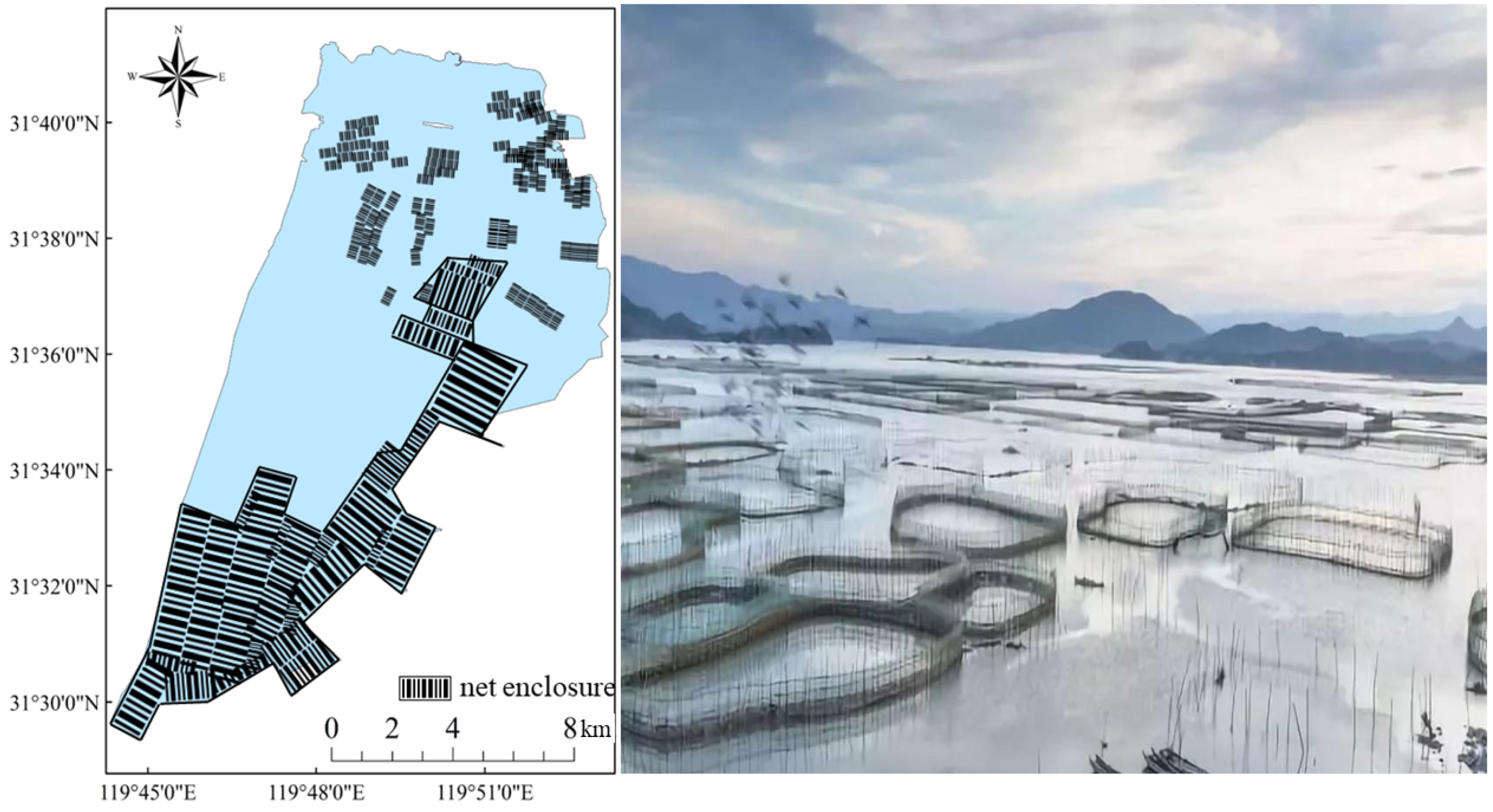
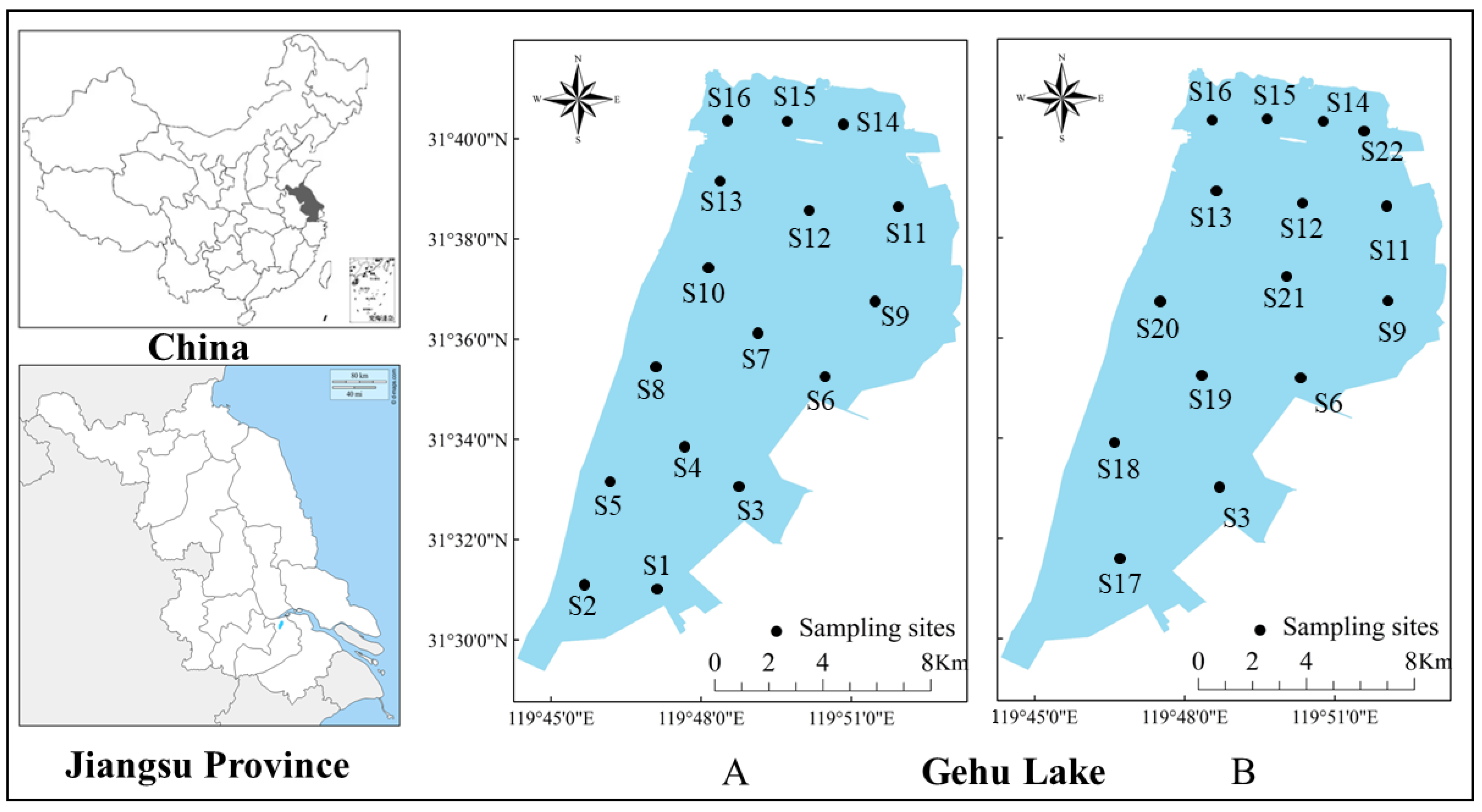
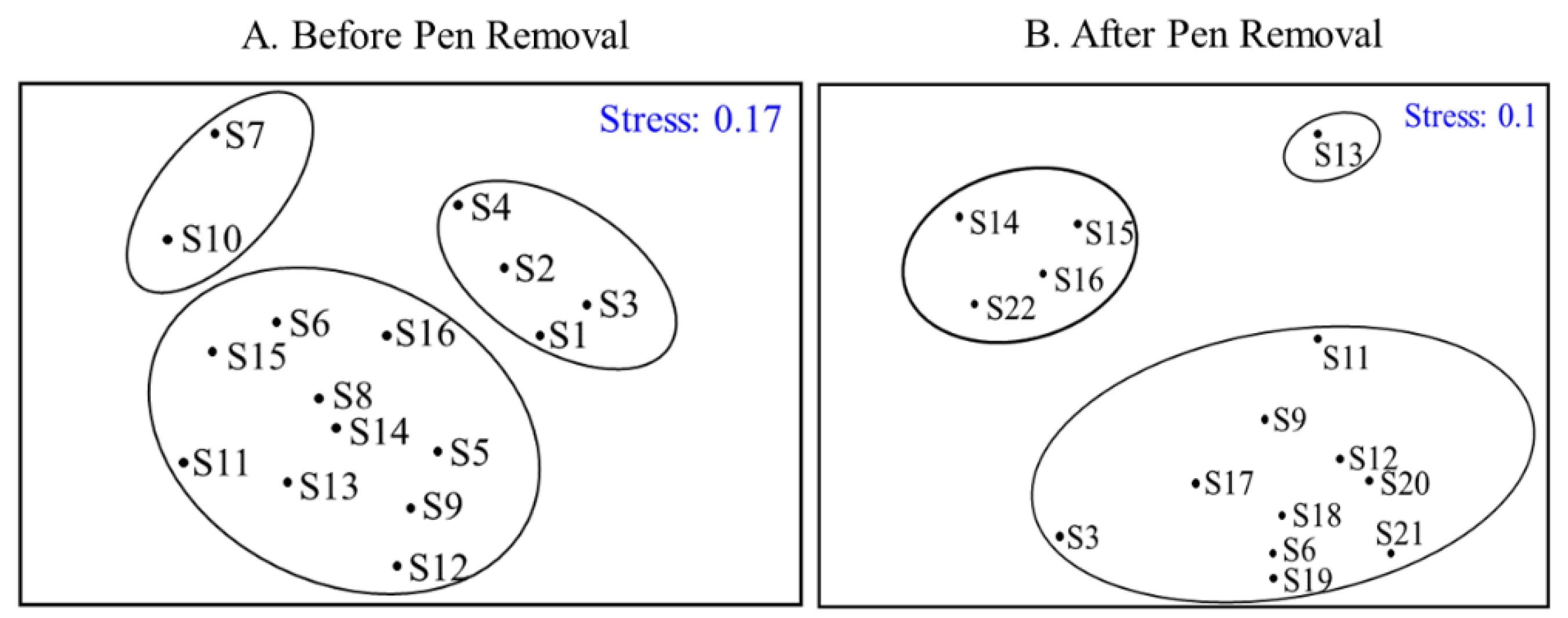
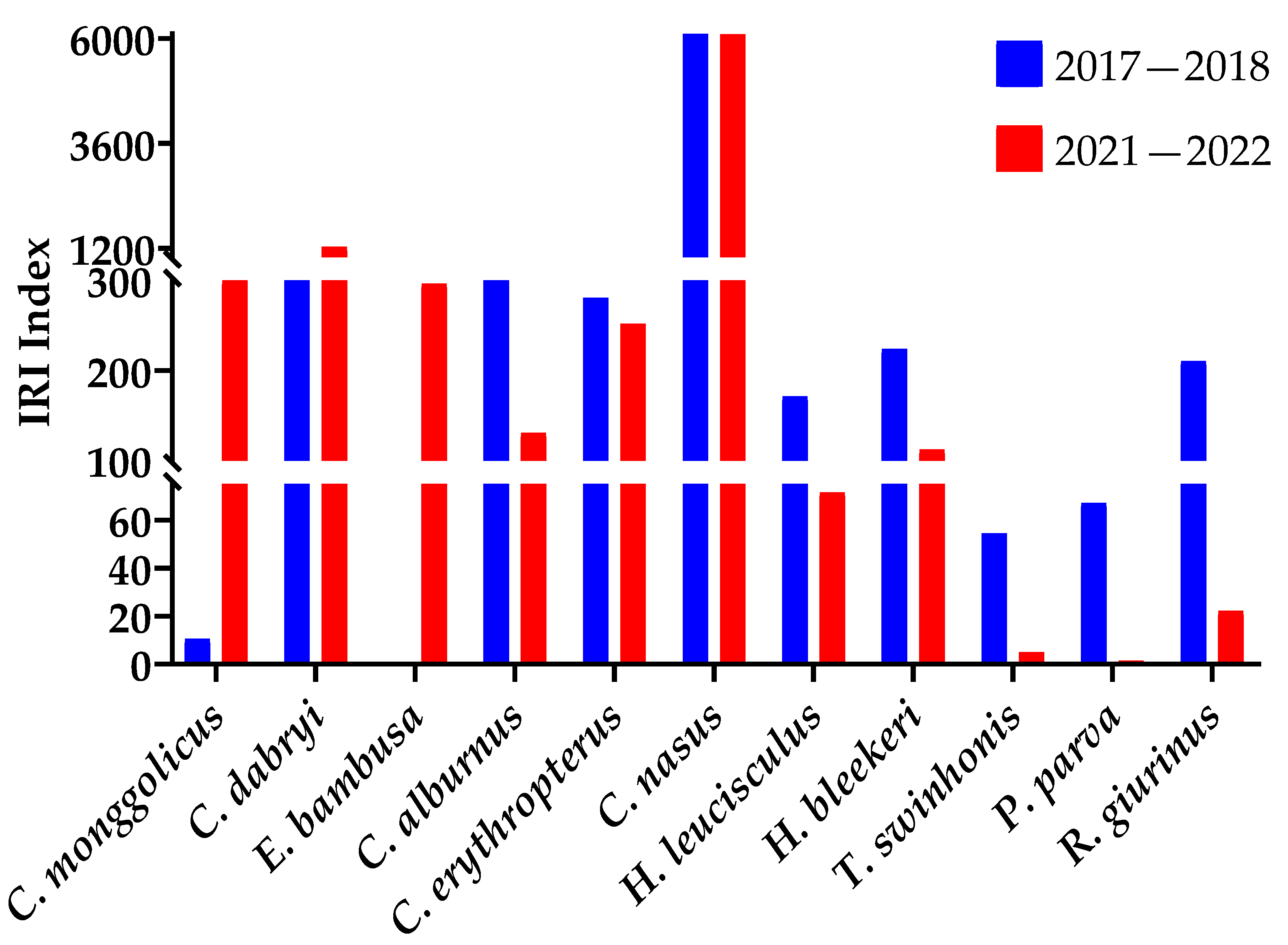
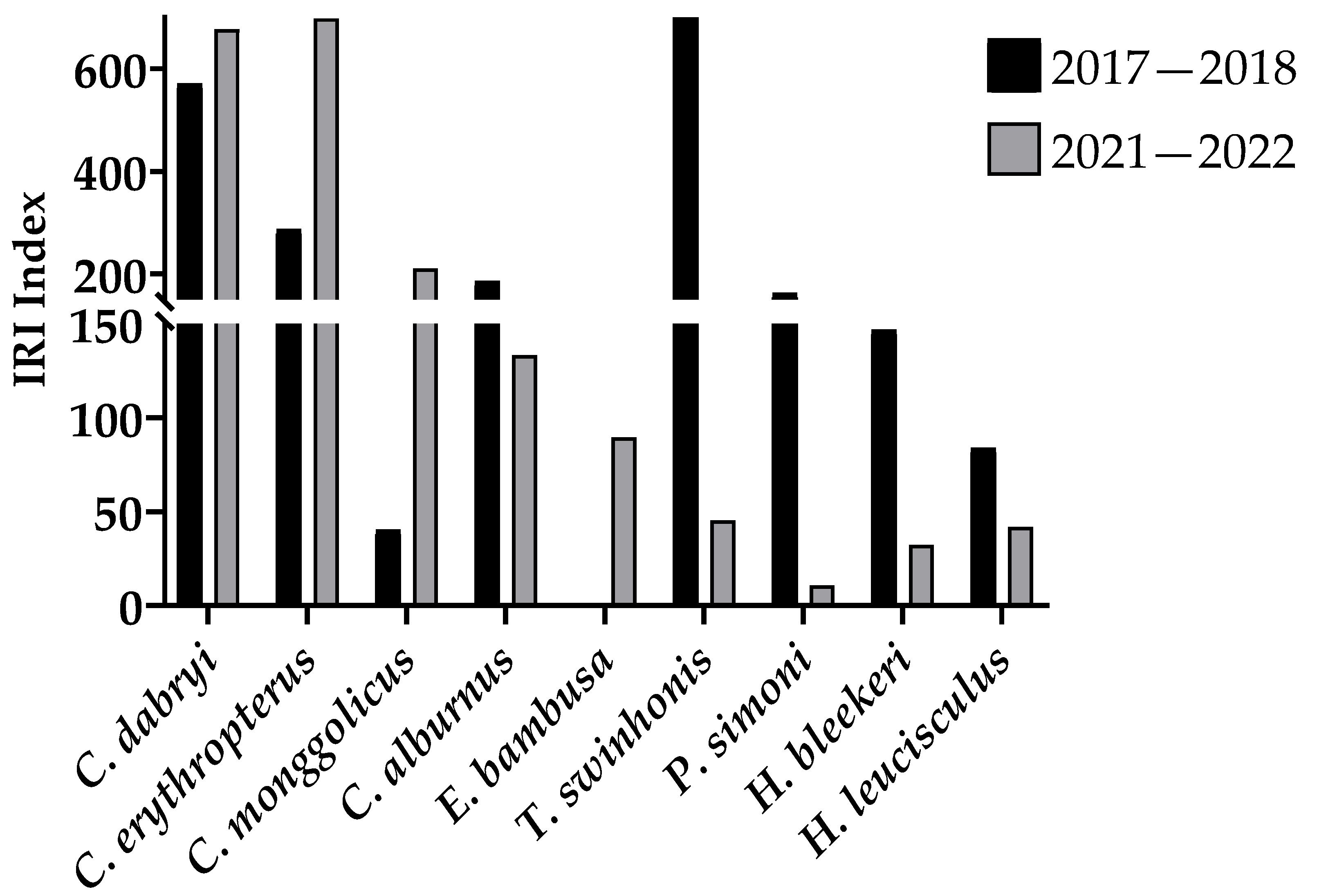
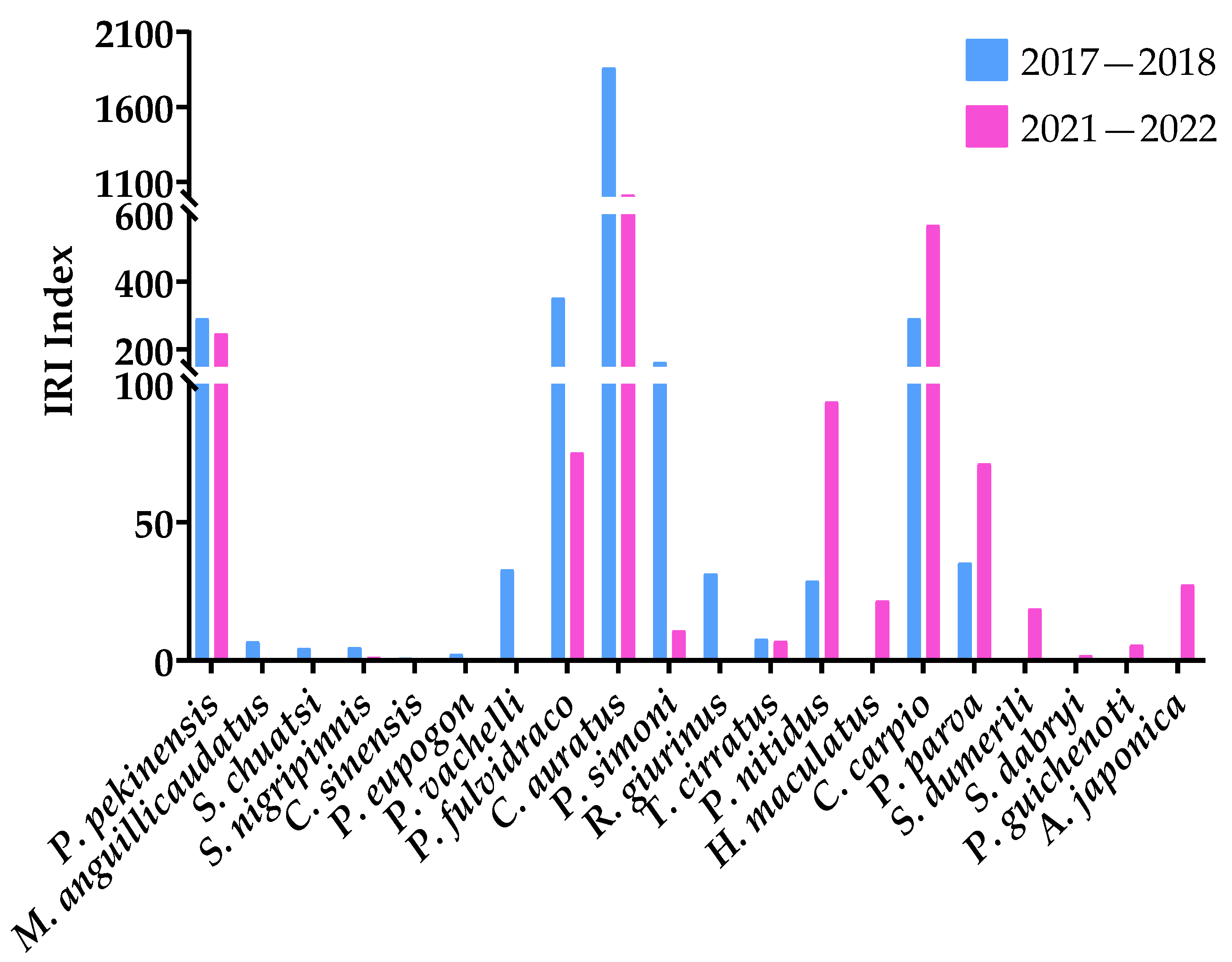

| Family | Species | 2017–2018 | 2021–2022 | FFG | EG | NAG |
|---|---|---|---|---|---|---|
| Engraulidae | Coilia nasus | √ | √ | plankt | ES | Nat |
| Cyprinidae | Abbottina rivularis | √ | plankt | SE | Nat | |
| Hemiculter bleekeri | √ | √ | herbivores | SE | Nat | |
| Parabramis pekinensis | √ | √ | herbivores | RL | Nat | |
| Hemiculter leucisculus | √ | √ | detritivores | SE | Nat | |
| Ctenopharyngodon idella | √ | √ | herbivores | RL | Nat | |
| Culter dabryi | √ | √ | piscivores | SE | Nat | |
| Acheilognathus macropterus | √ | √ | plankt | SE | Nat | |
| Megalobrama skolkovii | √ | zoobenthivores | SE | Nat | ||
| Elopichthys bambusa | √ | piscivores | RL | Nat | ||
| Pseudolaubuca engraulis | √ | √ | detritivores | RL | Nat | |
| Sarcocheilichthys nigripinnis | √ | √ | zoobenthivores | SE | Nat | |
| Cultrichthys erythropterus | √ | √ | plankt | SE | Nat | |
| Hemibarbus maculatus | √ | zoobenthivores | SE | Nat | ||
| Xenocypris davidi | √ | √ | detritivores | RL | Nat | |
| Aristichthys nobilis | √ | √ | detritivores | SE | Nat | |
| Cyprinus carpio | √ | √ | plankt | SE | Nat | |
| Cyprinus carpio × Carassius auratus | √ | plankt | SE | Non-Nat | ||
| Hypophthalmichthys molitrix | √ | √ | phytoplankt | RL | Nat | |
| Cirrhinus mrigala | √ | phytoplankt | RL | Ali | ||
| Pseudorasbora parva | √ | √ | plankt | SE | Nat | |
| Culter mongolicus | √ | √ | plankt | RL | Nat | |
| Culter alburnus | √ | √ | plankt | RL | Nat | |
| Saurogobio dabryi | √ | plankt | SE | Nat | ||
| Pseudobrama simoni | √ | √ | phytobenthivores | RL | Nat | |
| Paracanthobrama guichenoti | √ | zoobenthivores | SE | Nat | ||
| Toxabramis swinhonis | √ | √ | plankt | SE | Nat | |
| Megalobrama amblycephala | √ | √ | herbivores | SE | Nat | |
| Xenocypris microlepis | √ | detritivores | RL | Nat | ||
| Acheilognathus chankaensis | √ | √ | phytobenthivores | SE | Nat | |
| Xenocypris macrolepis | √ | detritivores | RL | Nat | ||
| Aristichthys nobilis | √ | √ | plankt | RL | Nat | |
| Saurogobio dumerili | √ | √ | plankt | SE | Nat | |
| Rhodeus fangi | √ | phytobenthivores | SE | Nat | ||
| Sarcocheilichthys sinensis | √ | zoobenthivores | SE | Nat | ||
| Bagridae | Pelteobaggrus nitidus | √ | √ | plankt | SE | Nat |
| Pelteobagrus vachelli | √ | √ | plankt | SE | Nat | |
| Pelteobaggrus fulvidraco | √ | √ | plankt | SE | Nat | |
| Pelteobagrus eupogon | √ | plankt | SE | Nat | ||
| Anguillidae | Anguilla japonica | √ | zoobenthivores | RS | Non-Nat | |
| Serranidae | Siniperca kneri garman | √ | piscivores | SE | Nat | |
| Siniperca chuatsi | √ | √ | piscivores | SE | Nat | |
| Cobitidae | Paramisgurnus dabryanus | √ | plankt | SE | Nat | |
| Misgurnus anguillicaudatus | √ | √ | plankt | SE | Nat | |
| Cobitis sinensis | √ | plankt | SE | Nat | ||
| Gobiidae | Taenioides cirratus | √ | √ | zoobenthivores | SE | Nat |
| Rhinogobius giurinus | √ | √ | zoobenthivores | SE | Nat | |
| Odontamblyopus rubicundus | √ | piscivores | SE | Nat | ||
| Salangidae | Protosalanx chinensis | √ | √ | piscivores | ES | Nat |
| Channidae | Channa argus | √ | √ | piscivores | SE | Nat |
| Hemirhamphiade | Hyporhamphus intermedius | √ | √ | plankt | ES | Nat |
| Fish (Species) | 2017–2018 IRI | 2021–2022 IRI |
|---|---|---|
| Coilia nasus | 7175.80 | 9074.44 |
| Hypophthalmichthys molitrix | 5595.01 | 3296.75 |
| Hypophthalmichthys nobilis | 1778.82 | 2766.67 |
| Carassius auratus | 1112.13 | 1010.61 |
| Chanodichthys dabryi | 595.49 | 588.53 |
| Cyprinus carpio | 431.63 | 518.28 |
| Chanodichthys erythropterus | 495.82 | 473.40 |
| Parabramis pekinensis | 26.99 | 298.25 |
| Megalobrama amblycephala | 28.61 | 170.22 |
| Pelteobaggrus nitidus | 293.32 | 156.89 |
| Pelteobaggrus fulvidraco | 371.49 | 126.15 |
| Toxabramis swinhonis | 247.95 | 122.29 |
| Culter mongolicus | 11.12 | 118.43 |
| Elopichthys bambusa | 0 | 109.35 |
| Hemiculter leucisculus | 102.45 | 102.60 |
| Culter alburnus | 341.43 | 92.40 |
| Hemiculter bleekeri | 186.22 | 39.23 |
| Pseudobrama simoni | 141.90 | 44.97 |
| IRI | N% | |||
|---|---|---|---|---|
| Fish (Species) | 2017–2018 | 2021–2022 | 2017–2018 | 2021–2022 |
| Coilia nasus | 7048.78 | 6090.03 | 63.66 | 55.12 |
| Hypophthalmichthys molitrix | 6312.64 | 2588.34 | 7.71 | 2.10 |
| Aristichthys nobilis | 1602.66 | 3454.88 | 1.22 | 2.97 |
| Carassius auratus | 1250.46 | 1443.32 | 6.72 | 5.85 |
| Culter dabryi | 893.77 | 1226.79 | 2.82 | 7.60 |
| Culter alburnus | 573.32 | 130.55 | 1.91 | 0.97 |
| Pseudobrama simoni | 387.80 | 118.06 | 3.44 | 1.02 |
| Pseudobagrus fulvidraco | 282.55 | 194.24 | 2.21 | 1.17 |
| Culterichthys erythropterus | 280.84 | 251.88 | 1.30 | 1.27 |
| Pelteobaggrus nitidus | 240.74 | 371.31 | 2.06 | 3.22 |
| Hemiculter bleekeri | 223.53 | 112.09 | 2.06 | 1.46 |
| Rhinogobius giurinus | 210.27 | 22.04 | 0.46 | 0.29 |
| Hemiculter leucisculus | 171.22 | 71.49 | 1.45 | 0.93 |
| Cyprinus carpio | 93.80 | 744.07 | 0.69 | 1.32 |
| Pseudorasbora parva | 67.04 | 1.23 | 0.38 | 0.05 |
| Toxabramis swinhonis | 54.41 | 4.93 | 0.69 | 0.10 |
| Misgurnus anguillcaudatus | 53.69 | 1.36 | 0.53 | 0.05 |
| Culter mongolocus | 10.43 | 299.77 | 0.08 | 2.44 |
| Ctenopharyngodon idellus | 7.19 | 2.69 | 0.08 | 0.10 |
| Acheilognathus macropterus | 5.61 | 177.22 | 0.15 | 1.71 |
| Pseudolaubuca engraulis | 4.83 | 1.44 | 0.08 | 0.05 |
| Pelteobagrus uachelli | 3.14 | 2.35 | 0.08 | 0.05 |
| Acheilognathus chankaensis | 2.80 | 3.84 | 0.08 | 0.15 |
| Sarcocheilichthys sinensis | 2.72 | 0.00 | 0.08 | 0.00 |
| Saurogobio dumerili | 2.63 | 18.41 | 0.08 | 0.19 |
| Parabramis pekinensis | 674.88 | 1.61 | ||
| Paracanthobrama guichenoti | 336.13 | 2.10 | ||
| Elopichthys bambusa | 296.26 | 0.63 | ||
| Saurogobio dabryi | 250.86 | 2.14 | ||
| Xenocypris davidi | 190.78 | 0.78 | ||
| Hemibarbus maculatus | 182.26 | 0.78 | ||
| Plagiognathops microlepis | 146.51 | 0.40 | ||
| Megalobrama amblycephala | 123.97 | 0.58 | ||
| Megalobrama skolkovii | 44.41 | 0.19 | ||
| Cyprinus carpio × Carassius auratus | 19.77 | 0.15 | ||
| Sarcocheilichthys nigripinnis | 15.14 | 0.19 | ||
| Channa argus | 6.84 | 0.05 | ||
| Anguilla japonica | 3.32 | 0.05 | ||
| Siniperca chuatsi | 3.27 | 0.05 | ||
| Xenocyprisargentea | 2.20 | 0.05 | ||
| Paramisgurnus dabryanus | 1.82 | 0.05 | ||
| Abbottina rivularis | 1.23 | 0.05 | ||
| IRI | N% | |||
|---|---|---|---|---|
| Fish (Species) | 2017–2018 | 2021–2022 | 2017–2018 | 2021–2022 |
| Coilia nasus | 7336.27 | 8401.58 | 62.93 | 73.89 |
| Hypophthalmichthys molitrix | 4944.75 | 4619.04 | 7.51 | 5.22 |
| Carassius auratus | 1859.89 | 1011.72 | 4.32 | 3.75 |
| Aristichthys nobilis | 1181.84 | 2398.36 | 0.66 | 2.07 |
| Toxabramis swinhonis | 1011.33 | 45.39 | 11.37 | 0.40 |
| Culter dabryi | 570.46 | 677.08 | 1.31 | 2.59 |
| Pseudobagrus fulvidraco | 352.63 | 75.05 | 1.77 | 0.43 |
| Cyprinus carpio | 291.22 | 567.67 | 0.35 | 0.82 |
| Parabramis pekinensis | 291.07 | 246.34 | 0.58 | 0.30 |
| Culterichthys erythropterus | 287.21 | 698.26 | 1.31 | 3.32 |
| Megalobrama amblycephala | 195.64 | 286.63 | 0.27 | 0.43 |
| Culter alburnus | 185.25 | 133.38 | 0.77 | 0.46 |
| Pseudobrama simoni | 162.10 | 10.76 | 1.70 | 0.12 |
| Hemiculter bleekeri | 146.81 | 32.50 | 0.35 | 0.30 |
| Hemiculter leucisculus | 83.75 | 41.93 | 0.73 | 0.52 |
| Culter mongolocus | 40.42 | 210.54 | 0.15 | 1.86 |
| Acheilognathus macropterus | 37.05 | 53.67 | 0.39 | 0.49 |
| Pseudorasbora parva | 35.28 | 71.09 | 0.35 | 1.04 |
| Pelteobagrus vachelli | 32.75 | 0.39 | ||
| Rhinogobius giurinus | 31.36 | 0.50 | ||
| Pelteobaggrus nitidus | 28.73 | 93.45 | 0.39 | 0.73 |
| Xenocypris davidi | 17.40 | 0.12 | ||
| Taenioides cirratus | 7.67 | 6.94 | 0.12 | 0.09 |
| Hyporhamphus intermedius | 7.42 | 1.05 | 0.12 | 0.03 |
| Misgurnus anguillicaudatus | 6.75 | 0.12 | ||
| Channa argus | 6.21 | 0.04 | ||
| Sarcocheilichthys nigripinnis | 4.68 | 1.17 | 0.19 | 0.03 |
| Siniperca chuatsi | 4.40 | 0.04 | ||
| Acheilognathus chankaensis | 3.61 | 0.08 | ||
| Pelteobagrus eupogon | 2.17 | 0.04 | ||
| Cobitis sinensis | 0.86 | 0.04 | ||
| Protosalanx hyalocranius | 0.79 | 24.01 | 0004 | 0.21 |
| Elopichthys bambusa | 89.69 | 0.34 | ||
| Anguilla japonica | 27.28 | 0.12 | ||
| Hemibarbus maculatus | 21.59 | 0.06 | ||
| Saurogobio dumerili | 18.72 | 0.18 | ||
| Paracanthobrama guichenoti | 5.61 | 0.09 | ||
| Megalobrama skolkovii | 2.03 | 0.03 | ||
| Saurogobio dabryi | 1.79 | 0.03 | ||
| Pseudolaubuca engraulis | 1.08 | 0.03 | ||
| Fish (Species) | IRI | N% | W% |
|---|---|---|---|
| Coilia nasus | 9899.20 | 80.11 | 18.88 |
| Aristichthys nobilis | 3035.60 | 1.97 | 28.39 |
| Hypophthalmichthys molitrix | 2171.77 | 1.68 | 20.03 |
| Carassius auratus | 668.49 | 2.10 | 6.81 |
| Cyprinus carpio | 530.74 | 0.48 | 4.83 |
| Culter dabryi | 440.69 | 0.96 | 3.44 |
| Culterichthys erythropterus | 377.63 | 1.31 | 2.46 |
| Parabramis pekinensis | 360.05 | 0.37 | 3.23 |
| Toxabramis swinhonis Günther | 351.81 | 2.84 | 0.67 |
| Hemiculter leucisculus | 242.55 | 2.30 | 0.13 |
| Pseudobagrus fulvidraco | 231.08 | 0.77 | 1.54 |
| Megalobrama amblycephala | 212.72 | 0.28 | 1.84 |
| Plagiognathops microlepis | 203.97 | 0.26 | 1.78 |
| Elopichthys bambusa | 165.08 | 0.22 | 1.98 |
| Pelteobaggrus nitidus | 152.51 | 1.18 | 0.34 |
| H′ | J′ | R′ | ||||
|---|---|---|---|---|---|---|
| Years | 2017–2018 | 2021–2022 | 2017–2018 | 2021–2022 | 2017–2018 | 2021–2022 |
| TL | 1.576 | 1.194 | 0.127 | 0.072 | 4.144 | 4.615 |
| NL | 1.656 | 2.020 | 0.202 | 0.184 | 3.401 | 5.245 |
| RL | 1.528 | 1.039 | 0.132 | 0.079 | 3.889 | 3.637 |
| SL | 1.537 | 1.258 | 0.145 | 0.113 | 3.943 | 3.706 |
Publisher’s Note: MDPI stays neutral with regard to jurisdictional claims in published maps and institutional affiliations. |
© 2022 by the authors. Licensee MDPI, Basel, Switzerland. This article is an open access article distributed under the terms and conditions of the Creative Commons Attribution (CC BY) license (https://creativecommons.org/licenses/by/4.0/).
Share and Cite
Ren, X.; Jiang, S.; Ren, L.; Liang, Y.; Fang, D.; Xu, D. Changes in Fish Assemblage Structure after Pen Culture Removal in Gehu Lake, China. Fishes 2022, 7, 382. https://doi.org/10.3390/fishes7060382
Ren X, Jiang S, Ren L, Liang Y, Fang D, Xu D. Changes in Fish Assemblage Structure after Pen Culture Removal in Gehu Lake, China. Fishes. 2022; 7(6):382. https://doi.org/10.3390/fishes7060382
Chicago/Turabian StyleRen, Xiaoliang, Shulun Jiang, Long Ren, Yidong Liang, Di’an Fang, and Dongpo Xu. 2022. "Changes in Fish Assemblage Structure after Pen Culture Removal in Gehu Lake, China" Fishes 7, no. 6: 382. https://doi.org/10.3390/fishes7060382
APA StyleRen, X., Jiang, S., Ren, L., Liang, Y., Fang, D., & Xu, D. (2022). Changes in Fish Assemblage Structure after Pen Culture Removal in Gehu Lake, China. Fishes, 7(6), 382. https://doi.org/10.3390/fishes7060382






